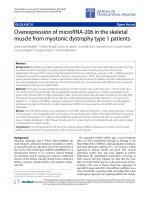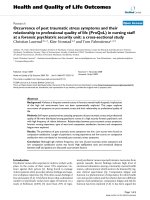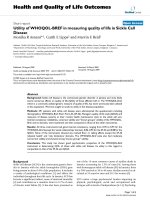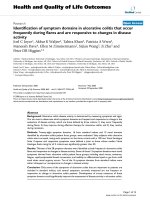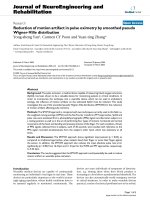báo cáo hóa học: " Occurrence of post traumatic stress symptoms and their relationship to professional quality of life (ProQoL) in nursing staff at a forensic psychiatric security unit: a cross-sectional study" potx
Bạn đang xem bản rút gọn của tài liệu. Xem và tải ngay bản đầy đủ của tài liệu tại đây (238.33 KB, 6 trang )
BioMed Central
Page 1 of 6
(page number not for citation purposes)
Health and Quality of Life Outcomes
Open Access
Research
Occurrence of post traumatic stress symptoms and their
relationship to professional quality of life (ProQoL) in nursing staff
at a forensic psychiatric security unit: a cross-sectional study
Christian Lauvrud*
1,2
, Kåre Nonstad
1,2
and Tom Palmstierna
1,2,3
Address:
1
St. Olav's University Hospital, Division of Psychiatry, Forensic department Brøset, Centre for Research and Education in Forensic
Psychiatry, Trondheim, Norway,
2
Dep. of Neuroscience, Faculty of Medicine NTNU, Trondheim, Norway and
3
Karolinska Institutet, Department
of Clinical Neuroscience, Division of Forensic Psychiatry, Stockholm, Sweden
Email: Christian Lauvrud* - ; Kåre Nonstad - ; Tom Palmstierna -
* Corresponding author
Abstract
Background: Violence is frequent towards nurses in forensic mental health hospitals. Implications
of this high risk environment have not been systematically explored. This paper explores
occurrence of symptoms on post traumatic stress and their relationship to professional quality of
life.
Methods: Self report questionnaires assessing symptoms of post traumatic stress and professional
quality of life were distributed among psychiatric nurses in a high security forensic psychiatric unit
with high frequency of violent behaviour. Relationships between post traumatic stress symptoms,
forensic nursing experience, type of ward and compassion satisfaction, burnout and compassion
fatigue were explored.
Results: The prevalence of post traumatic stress symptoms was low. Low scores were found on
compassion satisfaction. Length of psychiatric nursing experience and low scores on compassion
satisfaction were correlated to increased post traumatic stress symptoms.
Conclusion: Although high violence frequency, low rate of post traumatic stress symptoms and
low compassion satisfaction scores was found. High staff/patient ratio and emotional distance
between staff and patients are discussed as protective factors.
Introduction
Psychiatric nurses often experience violence at their work-
place. In the course of their career 70% experience vio-
lence against their person [1]. Being forced to manage
violent patients often provokes adverse feelings and nega-
tive workplace experience [2]. This often causes feelings of
fear and anxiety [3,4]. It has been shown that a substantial
number of psychiatric nurses have signs of burnout. In a
study of Robinson (2003) [5] more than 20% of regis-
tered psychiatric nurses reported intrusive memories from
patient assaults. Recent findings indicate high level of
emotional exhaustion among community mental health
nurses, a phenomenon which seems to be lessened by reg-
ular clinical supervision [6]. Compassion fatigue and
burnout is a phenomenon of importance for other health
care and social workers and the relation between different
aspects of job satisfaction, compassion fatigue and risk for
burnout has been explored [7,8]. It has been argued the
Published: 16 April 2009
Health and Quality of Life Outcomes 2009, 7:31 doi:10.1186/1477-7525-7-31
Received: 11 November 2008
Accepted: 16 April 2009
This article is available from: />© 2009 Lauvrud et al; licensee BioMed Central Ltd.
This is an Open Access article distributed under the terms of the Creative Commons Attribution License ( />),
which permits unrestricted use, distribution, and reproduction in any medium, provided the original work is properly cited.
Health and Quality of Life Outcomes 2009, 7:31 />Page 2 of 6
(page number not for citation purposes)
role conflict, a special feature in psychiatry caring as to the
amount of violence nurses are forced to handle, that this
role conflict in combination with low job satisfaction
would promote burnout [9]. The role of violence directed
towards nurses has already been shown to have a severe
psychological impact on nurses afflicted [10]. Experienc-
ing violence also increase the risk of more long term psy-
chological consequences. The risk of having to leave
nursing profession due to psychological consequences is
substantial [11] and risk for post traumatic stress disorder
(PTSD) after assaults against nurses is demonstrated high
[12]. Since psychiatric units and especially forensic psy-
chiatric units have a high degree of violence towards
nurses it could be expected that burnout risks and symp-
toms of PTSD are prevalent among nurses in such institu-
tions.
Interestingly in spite of being a high risk exposure envi-
ronment the high security forensic psychiatry and the rela-
tionship between, and occurrence of job satisfaction,
burnout and post traumatic stress symptoms has not been
explored.
The aim of this present study is to explore relations
between, and occurrence of, job satisfaction, burnout and
post traumatic stress symptoms among nurses in high fre-
quency violence environment.
Methods
Setting
The study was conducted in 2006 among nurses at Brøset
regional secure unit. Brøset is a high secure forensic unit
for severely mentally disordered patients too difficult to
manage in acute and long-term psychiatric settings.
Patients referred to Brøset are either sentenced to psychi-
atric care or referred from general psychiatric care units
because of severe mental disorder or severe learning disa-
bilities together with severe behaviour problems, mainly
of a violent character. The patients referred to Brøset are
considered too difficult to treat in the ordinary health care
system. The majority of the patients are admitted on coer-
cion. The unit serves regions in the central and northern
parts of Norway with about 1.1 million inhabitants. The
unit consists of 4 wards with a total number of 21 beds.
One of the wards (ward F) is specialised to serve offenders
with learning (intellectual) disabilities. The other three
wards have different levels of control and structured envi-
ronment in order to fit the needs of controlling the
patients behaviour (ward A, admission ward with the
highest structure, ward B intermediate and ward C with
the least structure). This year the unit had a relatively high
frequency of violence. During the year of the study
(2006), staff experienced 221 incidents of threat and vio-
lence corresponding to 13.8 incidents/bed/year of which
7.4 incidents/bed/year were physical attacks on staff
members. This frequency is higher than the average gen-
eral acute ward where the overall frequency of violence in
European countries is estimated to about 9.3 incidents/
bed/year [13]. The higher frequency of violence at Brøset
could be explained by the fact that patients admitted to
Brøset are those with the most severe behavioural prob-
lems in the region.
Assessments
Approximately 100 staff members were administered
questionnaires regarding occurrence of post traumatic
stress symptoms and their professional quality of life. For
assessing post traumatic stress symptoms, the PTSD
Checklist, civilian version (PCL-C) was used [14,15]. This
is a 17- item self report measure developed to assess symp-
toms following the criteria for post traumatic stress disor-
der in the Diagnostic and Statistical Manual of Mental
Disorders (DSM-IV). The different symptoms are
answered by the respondent on a 5-point Likert scale to
rate the extent to which they had been bothered in the
past month by 17 symptoms of post traumatic stress
based on the DSM-IV symptom clusters: reexperiencing,
avoidance/numbing, and arousal. Weathers et al. [15]
suggested that a symptom should be considered as meet-
ing the threshold criterion if an individual reports that it
has bothered him or her moderately, quite a bit, or
extremely (i.e., an item endorsement of 3 or greater on the
Likert scale).
Assessments of professional quality of life were made with
the Professional Quality of Life Scale (ProQOL) [16],
which is a validated development of the Compassion
Fatigue Test [17]. ProQOL is a 30 item self-report measure
to assess the dimensions compassion satisfaction, burn-
out and compassion fatigue. The compassion satisfaction
dimension (CS) measures pleasure derived from being
able to do you work well where high scores represent a
greater satisfaction related to your ability to be an effective
caregiver. The burnout dimension (BO) in this scale is
associated with feelings of hopelessness and difficulties in
dealing with your work. Higher scores are related to
higher risk for burnout. The compassion fatigue dimen-
sion (CF) relates to work-related secondary exposure to
extremely stressful events. High scores indicate that you
are exposed to frightening experiences at work.
The questionnaires were distributed anonymously, with-
out data on gender or age in order to minimise bias in self
reporting of symptoms possibly related to workplace situ-
ation.
The regional committee on research ethics was consulted
and the committee considered this study not liable for for-
mal approval as only staff members participated and the
study was part of the hospitals internal actions to initiate
Health and Quality of Life Outcomes 2009, 7:31 />Page 3 of 6
(page number not for citation purposes)
steps to ensure quality practice. The committee found this
study to be in no conflict with medical research ethics
according to the Helsinki declaration. The study design
was presented and approved by the hospitals employee
representatives and personnel safety representatives.
Participants
At Brøset there are 100 fulltime nursing position corre-
sponding to a high patient-to-staff level of 1:5. 100 ques-
tionnaires were sent out to ordinary members of the
nursing staff. 70 questionnaires were returned. No
reminders were sent out. Of the 70 respondents, 33
(47.1%) had >12 years of nursing experience in psychia-
try, 24 (34.2%) had 4–12 years of experience and only 13
(18.6%) had less than 4 years of experience. Among the
respondents, the most experienced staff worked at the
most highly structured ward, ward A (table 1). Of the
respondents, only 7 had a position of < 50% of full time
work at the unit. The respondents were evenly distributed
over the three wards, 11 (15.7%) worked at the ward for
patients with learning disabilities, 21 (30%) worked at the
most highly and restricted ward, 16 (22.9%) at the least
restricted ward and 22 (31.4%) worked at the ward with
intermediate restrictive environment (see Table 1: Length
of psychiatric nursing experience – Ward cross tabula-
tion).
Statistics
Occurrences of any PTSD symptom as rated with PCL-C
were correlated to items in the ProQOL scale, ward and
years of experience in forensic psychiatric care with a mul-
tiple logistic regression procedure. The Statistical Package
for Social Sciences, SPSS 14.0 for Windows was used.
Results
Sixty-seven of the 70 respondents (95.7%) met criterion A
(exposure) according to the PTSD diagnosis in DSM-IV,
reporting within the last 30 days i.e. either a.) exposed to
real threats containing serious physical violence, b.) wit-
nessed others exposed to serious physical violence (kick-
ing, beatings e.g.) or c.) self being exposed to serious
physical violence.
None of the respondents filled criterions for full PTSD
diagnosis. Three (4.3%) reported at least one symptom
occurring moderately (i.e. scoring at least 3 on the Likert
scale) in each of cluster B, C and D (re-experience, avoid-
ance, increased arousal). Seventeen (24.3%) reported at
least one symptom occurring within either cluster B (re-
experience), C (avoidance) or D (increased arousal).
Ward A's mean total sum of clusters B, C and D in the
PCL-C, indicating overall stress symptoms, was 25.4 (95%
CI 22.4–28.4), ward B; 19.7 (95% CI 18.3–21.1), ward C;
19.7 (95% CI 18.1–21.3), ward F; 21.7 (CI 95% 17.6–
25.9), df = 3:66, F-value = 6.03, p = .001, thus indicating
a higher rate of PTSD symptoms at ward A.
Generally, compared to normative data, mean Compas-
sion Satisfaction scores (CS) were low at all the wards. At
ward A; mean CS was 30.2, (SD 6.5). Ward B; mean =
35.7, (SD 6.5). Ward C; mean = 31.5, (SD 8.3). Ward F;
mean = 34 (SD 6.1) (See Figure 1).
Burnout scale (BO) and Compassion Fatigue (CF) was in
all four wards reported well below average scores accord-
ing to normative data in the ProQOL manual (Figure 2
and Figure 3). Total mean BO was 17.3 (SD 4.4) and total
mean CF was 5.8 (SD 3.6). In the boxplot Figure 1, Figure
Table 1: Length of psychiatric nursing experience – Ward cross tabulation
years A B C F Total
Length of psychiatric nursing experience 0–3 2 4 5 2 13
9.5% 18.2% 31.3% 18.2% 18,6%
4–6 3 4 3 2 12
14.3% 18.2% 18.8% 18.2% 17,1%
7–935008
14.3% 22.7% .0% .0% 11,4%
10–1212104
4.8% 9.1% 6.3% .0% 5,7%
over 12 12 7 7 7 33
57.1% 31.8% 43.8% 63.6% 47,1%
Total N 21 22 16 11 70
Health and Quality of Life Outcomes 2009, 7:31 />Page 4 of 6
(page number not for citation purposes)
2 and Figure 3, the separate distributions of scores for the
wards of the ProQOL dimension are presented relative to
normative data from the ProQOL manual [16] (see Figure
2 and Figure 3).
Occurrence of any symptoms of PTSD was related to the
variables length of psychiatric nursing experience, which
of the wards you were working at (as categorical variable)
and scoring on the variables Compassion Satisfaction
(CS), Burnout (BO) and Compassion Fatigue (CF) in the
ProQOL in a binary logistic regression model using a for-
ward stepwise method (Wald). In the final model, includ-
ing only variables significantly contributing to the model,
two variables were significant, length of psychiatric nurs-
ing experience (P = .028, HR = 1.76, CI 95% 1.06–2.90)
and scores on the CS (P = .027, HR = .90, CI 95% .81–
.99).
Discussion and conclusion
In this investigation of nursing staff working in a high fre-
quency violence psychiatric institution, a low prevalence
of post traumatic stress symptoms is found in spite of high
exposure to violence. A substantial number of respond-
ents had some symptoms, but only few even met criteria
for partial PTSD as defined by the International Consen-
sus Group on depression and anxiety [18]. Our results
seems substantially lower than those reported by Robin-
son (2003) [5] who reported 1.4% fulfilling PTSD criteria
and 35% having any PTSD symptoms in a population of
psychiatric nurses not selected from high security hospi-
tals. Also, Richter (2006) [12] reported a high number of
PTSD-syndrome (17%) in a population of recently
assaulted nurses of which 11% persisted more than 6
months. It seems not reasonable to assume that the nurses
in this investigation are less exposed to violence than the
Box plot indicating median, quartiles and extreme values for scores on CS at the different wardsFigure 1
Box plot indicating median, quartiles and extreme
values for scores on CS at the different wards. Hori-
zontal dotted lines indicate bottom quartile, median and top
quartile from normative data in the ProQOL manual [16].
FCBA
Wards
44
40
36
32
28
24
20
Compassion Satisfaction Scale
Boxplot indicating median, quartiles and extreme values for scores on BO at the different wardsFigure 2
Boxplot indicating median, quartiles and extreme
values for scores on BO at the different wards. Hori-
zontal dotted lines indicate bottom quartile, median and top
quartile from normative data in the ProQOL manual [16].
FCBA
Wards
28
26
24
22
20
18
16
14
12
10
8
BurnOut Scale
Health and Quality of Life Outcomes 2009, 7:31 />Page 5 of 6
(page number not for citation purposes)
above mentioned studies since 80% report being
assaulted and in total 95.7% met the exposure criteria (A)
of the DSM-IV.
The low prevalence of PTSD symptoms among nursing
staff at this unit could possibly be explained in several
ways. A number of traumatized staff members could have
had experienced symptoms of PSTD without being
detected in this study because of its cross-sectional design.
Some could have had decreased symptoms, some could
have left work because of symptoms and among those not
responding to the questionnaire, some nurses could have
had more symptoms and therefore being reluctant to
answer because of avoidance issues related to PTSD. But,
if these findings of low prevalence of PTSD symptoms
found in our study could be replicated with other designs,
this low prevalence could perhaps be explained by the
special characteristics of the Brøset clinic such as very high
patient/staff ratio (1:5), which together with a generally
strong collegiate spirit within the wards and a strong sense
of mutual experience throughout the unit could contrib-
ute to the low frequency of PTSD symptoms. The fact that
most of the staff is "still in the trenches" could also explain
the low presence of PTSD symptoms. They have not been
able to re-experience or avoid events as they regularly are
exposed to new violent traumatic conflicts. The emotional
distance between personnel and patients necessitated by a
high security ward and a primarily behaviour based
regime could possibly also reduce the emotional impact
of violence towards nurses and other staff.
There are however differences between the wards where
the admission ward (ward A) with the most restrictive
environment and the most disturbed patients have the
highest prevalence of PTSD symptoms. At the same time
the best predictor of having any PTSD symptoms were
long experience and low compassion satisfaction. The
finding that long experience predicts symptoms is previ-
ously known. It could be speculated that experienced staff
with PTSD symptoms tend to stay at a ward with high
structure and less need for engagement in patients rehabil-
itation. The long experience of these nurses leads both to
a higher exposure to violence, and therefore to higher
rates of post traumatic problems, and to a "natural brief-
ing" of the staff, so that nothing is unexpected, and there-
fore fewer things are potentially traumatizing.
One can also speculate on if one of the treatment princi-
ples, i.e. making the patient treatable at a lower security
level can explain the low compassion satisfaction scores at
ward A, the admission ward. At this particular forensic
unit, patients transfer to a ward with reduced security level
as soon as the patients are deemed receptive for treatment
in a more non-restrictive environment. This may diminish
staffs perception on completeness and a job well done.
From a career planning and manageable time perspective,
the finding of low compassion satisfaction and length of
experience in psychiatry predicting PTSD symptoms raise
questions on for how long nurses should work fulltime in
these high frequency violent environments. If these results
are further corroborated, perhaps career planning over
time should include reduced exposure to work with
severely violent patients and perhaps offer other tasks
duties instead, such as e.g. training and mentoring
younger colleagues or like other highly violence exposed
professions, acknowledge reduced retirement age such as
is the case with police officers and firemen.
Competing interests
The authors declare that they have no competing interests.
Boxplot indicating median, quartiles and extreme values for scores on CF at the different wardsFigure 3
Boxplot indicating median, quartiles and extreme
values for scores on CF at the different wards. Hori-
zontal dotted lines indicate bottom quartile, median and top
quartile from normative data in the ProQOL manual [16].
FCBA
Wards
16
14
12
10
8
6
4
2
0
Compassion Fatigue Scale
Publish with BioMed Central and every
scientist can read your work free of charge
"BioMed Central will be the most significant development for
disseminating the results of biomedical research in our lifetime."
Sir Paul Nurse, Cancer Research UK
Your research papers will be:
available free of charge to the entire biomedical community
peer reviewed and published immediately upon acceptance
cited in PubMed and archived on PubMed Central
yours — you keep the copyright
Submit your manuscript here:
/>BioMedcentral
Health and Quality of Life Outcomes 2009, 7:31 />Page 6 of 6
(page number not for citation purposes)
Authors' contributions
CL, TP and KN conceived and designed the study. CL col-
lected the data. CL and TP performed statistical analysis
and drafted the manuscript. All authors revised the man-
uscript critically and approved the final manuscript.
Acknowledgements
The authors wish to acknowledge system manager Erik Kroppan at Brøset
forensic hospital for accessing violence data material from the hospital.
References
1. Abderhalden C, Needham I, Friedli TK, Poelmans J, Dassen T: Per-
ception of aggression among psychiatric nurses in Switzer-
land. Acta Psychiatr Scand Suppl 2002:110-117.
2. Needham I, Abderhalden C, Halfens RJ, Dassen T, Haug HJ, Fischer
JE: The Impact of Patient Aggression on Carers Scale: instru-
ment derivation and psychometric testing. Scand J Caring Sci
2005, 19(3):296-300.
3. Whittington R, Wykes T: Staff strain and social support in a psy-
chiatric hospital following assault by a patient. J Adv Nurs 1992,
17(4):480-486.
4. Lanza ML: The reactions of nursing staff to physical assault by
a patient. Hosp Community Psychiatry 1983, 34(1):44-47.
5. Robinson JR, Clements K, Land C: Workplace stress among psy-
chiatric nurses. Prevalence, distribution, correlates, & pre-
dictors. J Psychosoc Nurs Ment Health Serv 2003, 41(4):32-41.
6. Edwards D, Burnard P, Hannigan B, Cooper L, Adams J, Juggessur T,
Fothergil A, Coyle D: Clinical supervision and burnout: the
influence of clinical supervision for community mental
health nurses. J Clin Nurs 2006, 15(8):1007-1015.
7. Conrad D, Kellar-Guenther Y: Compassion fatigue, burnout,
and compassion satisfaction among Colorado child protec-
tion workers. Child Abuse Negl 2006, 30(10):1071-1080.
8. Adams RERE, Boscarino JAJA, Figley CRCR: Compassion fatigue
and psychological distress among social workers: a validation
study. Am J Orthopsychiatry 2006, 76(1):103-108.
9. Piko BF: Burnout, role conflict, job satisfaction and psychoso-
cial health among Hungarian health care staff: a question-
naire survey. Int J Nurs Stud 2006, 43(3):311-318.
10. Inoue M, Tsukano K, Muraoka M, Kaneko F, Okamura H: Psycholog-
ical impact of verbal abuse and violence by patients on
nurses working in psychiatric departments. Psychiatry Clin Neu-
rosci 2006, 60(1):29-36.
11. Hunter M, Carmel H: The cost of staff injuries from inpatient
violence. Hosp Community Psychiatry
1992, 43(6):586-588.
12. Richter D, Berger K: Post-traumatic stress disorder following
patient assaults among staff members of mental health hos-
pitals: a prospective longitudinal study. BMC psychiatry [elec-
tronic resource] 2006, 6:15.
13. Nijman HL, Palmstierna T, Almvik R, Stolker JJ: Fifteen years of
research with the Staff Observation Aggression Scale: a
review. Acta Psychiatr Scand 2005, 111(1):12-21.
14. Ruggiero KJ, Del Ben K, Scotti JR, Rabalais AE: Psychometric prop-
erties of the PTSD Checklist-Civilian Version. J Trauma Stress
2003, 16(5):495-502.
15. Weathers F, Litz B, Herman D, Huska J, Keane T: The PTSD
Checklist (PCL): Reliability, validity, and diagnostic utility.
Paper presented at the 9th annual meeting of the International Society for
Traumatic Stress Studies. San Antonio, TX 1993.
16. The ProQOL manual [ />]
17. Figley CR, Stamm BH: Psychometric Review of Compassion
Fatigue Self Test. In Measurement of Stress, Trauma and Adaptation
Edited by: Stamm BH. Lutherville, MD: Sidran Press; 1996.
18. Ballenger JC, Davidson JR, Lecrubier Y, Nutt DJ, Marshall RD,
Nemeroff CB, Shalev AY, Yehuda R: Consensus statement
update on posttraumatic stress disorder from the interna-
tional consensus group on depression and anxiety. J Clin Psy-
chiatry 2004, 65(Suppl 1):55-62.


